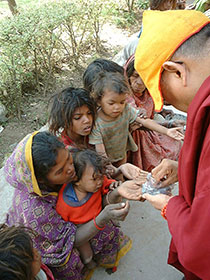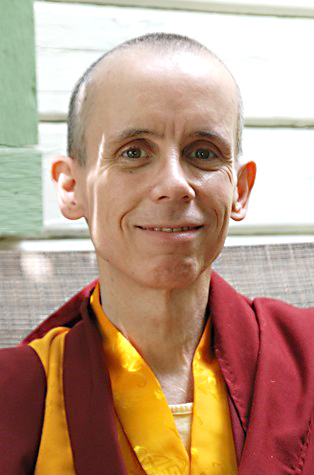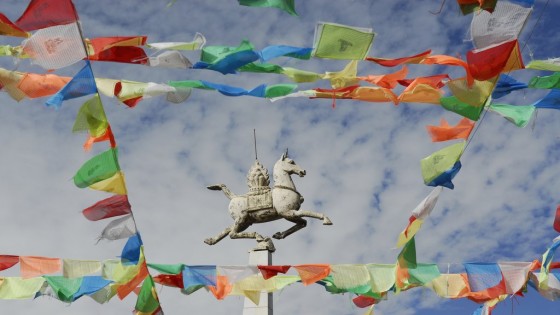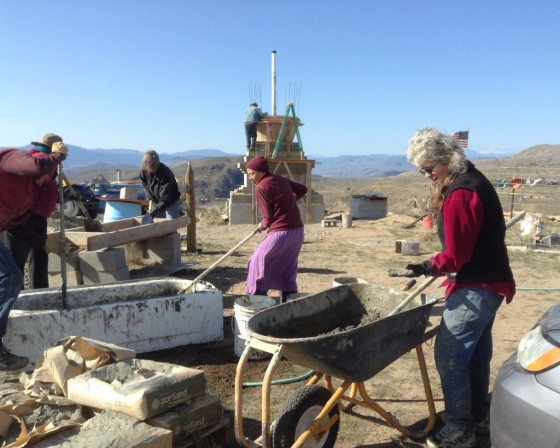- Home
- FPMT Homepage
Foundation for the Preservation of the Mahayana Tradition
The FPMT is an organization devoted to preserving and spreading Mahayana Buddhism worldwide by creating opportunities to listen, reflect, meditate, practice and actualize the unmistaken teachings of the Buddha and based on that experience spreading the Dharma to sentient beings. We provide integrated education through which people’s minds and hearts can be transformed into their highest potential for the benefit of others, inspired by an attitude of universal responsibility and service. We are committed to creating harmonious environments and helping all beings develop their full potential of infinite wisdom and compassion. Our organization is based on the Buddhist tradition of Lama Tsongkhapa of Tibet as taught to us by our founders Lama Thubten Yeshe and Lama Thubten Zopa Rinpoche.
- Willkommen
Die Stiftung zur Erhaltung der Mahayana Tradition (FPMT) ist eine Organisation, die sich weltweit für die Erhaltung und Verbreitung des Mahayana-Buddhismus einsetzt, indem sie Möglichkeiten schafft, den makellosen Lehren des Buddha zuzuhören, über sie zur reflektieren und zu meditieren und auf der Grundlage dieser Erfahrung das Dharma unter den Lebewesen zu verbreiten.
Wir bieten integrierte Schulungswege an, durch denen der Geist und das Herz der Menschen in ihr höchstes Potential verwandelt werden zum Wohl der anderen – inspiriert durch eine Haltung der universellen Verantwortung und dem Wunsch zu dienen. Wir haben uns verpflichtet, harmonische Umgebungen zu schaffen und allen Wesen zu helfen, ihr volles Potenzial unendlicher Weisheit und grenzenlosen Mitgefühls zu verwirklichen.
Unsere Organisation basiert auf der buddhistischen Tradition von Lama Tsongkhapa von Tibet, so wie sie uns von unseren Gründern Lama Thubten Yeshe und Lama Thubten Zopa Rinpoche gelehrt wird.
- Bienvenidos
La Fundación para la preservación de la tradición Mahayana (FPMT) es una organización que se dedica a preservar y difundir el budismo Mahayana en todo el mundo, creando oportunidades para escuchar, reflexionar, meditar, practicar y actualizar las enseñanzas inconfundibles de Buda y en base a esa experiencia difundir el Dharma a los seres.
Proporcionamos una educación integrada a través de la cual las mentes y los corazones de las personas se pueden transformar en su mayor potencial para el beneficio de los demás, inspirados por una actitud de responsabilidad y servicio universales. Estamos comprometidos a crear ambientes armoniosos y ayudar a todos los seres a desarrollar todo su potencial de infinita sabiduría y compasión.
Nuestra organización se basa en la tradición budista de Lama Tsongkhapa del Tíbet como nos lo enseñaron nuestros fundadores Lama Thubten Yeshe y Lama Zopa Rinpoche.
A continuación puede ver una lista de los centros y sus páginas web en su lengua preferida.
- Bienvenue
L’organisation de la FPMT a pour vocation la préservation et la diffusion du bouddhisme du mahayana dans le monde entier. Elle offre l’opportunité d’écouter, de réfléchir, de méditer, de pratiquer et de réaliser les enseignements excellents du Bouddha, pour ensuite transmettre le Dharma à tous les êtres. Nous proposons une formation intégrée grâce à laquelle le cœur et l’esprit de chacun peuvent accomplir leur potentiel le plus élevé pour le bien d’autrui, inspirés par le sens du service et une responsabilité universelle. Nous nous engageons à créer un environnement harmonieux et à aider tous les êtres à épanouir leur potentiel illimité de compassion et de sagesse. Notre organisation s’appuie sur la tradition guéloukpa de Lama Tsongkhapa du Tibet, telle qu’elle a été enseignée par nos fondateurs Lama Thoubtèn Yéshé et Lama Zopa Rinpoché.
Visitez le site de notre Editions Mahayana pour les traductions, conseils et nouvelles du Bureau international en français.
Voici une liste de centres et de leurs sites dans votre langue préférée
- Benvenuto
L’FPMT è un organizzazione il cui scopo è preservare e diffondere il Buddhismo Mahayana nel mondo, creando occasioni di ascolto, riflessione, meditazione e pratica dei perfetti insegnamenti del Buddha, al fine di attualizzare e diffondere il Dharma fra tutti gli esseri senzienti.
Offriamo un’educazione integrata, che può trasformare la mente e i cuori delle persone nel loro massimo potenziale, per il beneficio di tutti gli esseri, ispirati da un’attitudine di responsabilità universale e di servizio.
Il nostro obiettivo è quello di creare contesti armoniosi e aiutare tutti gli esseri a sviluppare in modo completo le proprie potenzialità di infinita saggezza e compassione.
La nostra organizzazione si basa sulla tradizione buddhista di Lama Tsongkhapa del Tibet, così come ci è stata insegnata dai nostri fondatori Lama Thubten Yeshe e Lama Zopa Rinpoche.
Di seguito potete trovare un elenco dei centri e dei loro siti nella lingua da voi prescelta.
- 欢迎 / 歡迎
简体中文
“护持大乘法脉基金会”( 英文简称:FPMT。全名:Foundation for the Preservation of the Mahayana Tradition) 是一个致力于护持和弘扬大乘佛法的国际佛教组织。我们提供听闻,思维,禅修,修行和实证佛陀无误教法的机会,以便让一切众生都能够享受佛法的指引和滋润。
我们全力创造和谐融洽的环境, 为人们提供解行并重的完整佛法教育,以便启发内在的环宇悲心及责任心,并开发内心所蕴藏的巨大潜能 — 无限的智慧与悲心 — 以便利益和服务一切有情。
FPMT的创办人是图腾耶喜喇嘛和喇嘛梭巴仁波切。我们所修习的是由两位上师所教导的,西藏喀巴大师的佛法传承。
繁體中文
護持大乘法脈基金會”( 英文簡稱:FPMT。全名:Found
ation for the Preservation of the Mahayana Tradition ) 是一個致力於護持和弘揚大乘佛法的國際佛教組織。我們提供聽聞, 思維,禪修,修行和實證佛陀無誤教法的機會,以便讓一切眾生都能 夠享受佛法的指引和滋潤。 我們全力創造和諧融洽的環境,
為人們提供解行並重的完整佛法教育,以便啟發內在的環宇悲心及責 任心,並開發內心所蘊藏的巨大潛能 — 無限的智慧與悲心 – – 以便利益和服務一切有情。 FPMT的創辦人是圖騰耶喜喇嘛和喇嘛梭巴仁波切。
我們所修習的是由兩位上師所教導的,西藏喀巴大師的佛法傳承。 察看道场信息:
- FPMT Homepage
- News/Media
-
- Study & Practice
-
-
- About FPMT Education Services
- Latest News
- Programs
- New to Buddhism?
- Buddhist Mind Science: Activating Your Potential
- Heart Advice for Death and Dying
- Discovering Buddhism
- Living in the Path
- Exploring Buddhism
- FPMT Basic Program
- FPMT Masters Program
- FPMT In-Depth Meditation Training
- Maitripa College
- Lotsawa Rinchen Zangpo Translator Program
- Universal Education for Compassion & Wisdom
- Online Learning Center
-
- Prayers & Practice Materials
- Overview of Prayers & Practices
- Full Catalogue of Prayers & Practice Materials
- Explore Popular Topics
- Benefiting Animals
- Chenrezig Resources
- Death & Dying Resources
- Lama Chopa (Guru Puja)
- Lama Zopa Rinpoche: Compendium of Precious Instructions
- Lama Zopa Rinpoche: Life Practice Advice
- Lama Zopa Rinpoche Practice Series
- Lamrim Resources
- Mantras
- Prayer Book Updates
- Purification Practices
- Sutras
- Thought Transformation (Lojong)
- Audio Materials
- Dharma Dates - Tibetan Calendar
- Translation Services
- Publishing Services
- Ways to Offer Support
- Prayers & Practice Materials
-
- Teachings and Advice
- Find Teachings and Advice
- Lama Zopa Rinpoche Advice Page
- Lama Zopa Rinpoche: Compendium of Precious Instructions
- Lama Zopa Rinpoche Video Teachings
- ༧སྐྱབས་རྗེ་བཟོད་པ་རིན་པོ་ཆེ་མཆོག་ནས་སྩལ་བའི་བཀའ་སློབ་བརྙན་འཕྲིན།
- Podcasts
- Lama Yeshe Wisdom Archive
- Buddhism FAQ
- Dharma for Young People
- Resources on Holy Objects
- Teachings and Advice
-
-
*If a menu item has a submenu clicking once will expand the menu clicking twice will open the page.
-
-
- Centers
-
- Teachers
-
- Projects
-
-
-
-
*If a menu item has a submenu clicking once will expand the menu clicking twice will open the page.
-
-
- FPMT
-
-
-
-
-
If you have fear of some pain or suffering, you should examine whether there is anything you can do about it. If you can, there is no need to worry about it; if you cannot do anything, then there is also no need to worry.
His Holiness the Dalai Lama
-
-
-
- Shop
-
-
-
The Foundation Store is FPMT’s online shop and features a vast selection of Buddhist study and practice materials written or recommended by our lineage gurus. These items include homestudy programs, prayers and practices in PDF or eBook format, materials for children, and other resources to support practitioners.
Items displayed in the shop are made available for Dharma practice and educational purposes, and never for the purpose of profiting from their sale. Please read FPMT Foundation Store Policy Regarding Dharma Items for more information.
-
-
Mandala
24
The Bliss of Practice
David Gonsalez (now, Ven. Losang Tsering) is a dedicated student of Dharma and founder of Dechen Ling Press. He has been diagnosed with a terminal illness and is sharing the spiritual insight he’s gained from the experience in an inspiring blog. In his most recent post he writes:
“Many years ago I was stuck by the poignancy of a statement Geshe Ngawang Dhargye made in one of his teachings I was reading where he stated that every moment is another opportunity to change the course of our lives, that how we decide to react right now, in this very moment, will have a long-lasting impact far into the future. It had a deep and lasting impact on me and made me acutely aware that we should never become complacent by thinking that just because we have reached a certain age or have been practicing Dharma for all these years and still keep making the same mistakes over and over that we shall never succeed. We never know just how many times we need to ‘fail’ at making wise and healthy decisions before we actually ‘succeed.’ …”
More than a decade ago, David Gonsalez spoke with Ven. Roger Kunsang about his spiritual development starting as a child with a penchant for philosophy to an adult connecting with a deep-seated love for Buddhist practice in the December 2002-February 2003 issue of Mandala:
Ven. Roger Kunsang: How did you first connect with the Dharma?
David Gonsalez: I read a book by His Holiness the Dalai Lama, Kindness Clarity and Insight, when I was twenty-three. At that point, I had already decided to find some purpose to my life, other than working, and had quit my job to find a spiritual path. I read the book, and that was it – that was the beginning.
VRK: Did you have any feeling or connection with the Dharma before that?
DG: Ever since I was a little boy I was always wondering about the deeper meaning of life and the world. When my mother said that [the] things that happened were because of God, I would think, “But I watched the situation. First someone did something, and then something else, and then something happened, so why do you think that God did it?” When I was very young, about five or six, and I did something wrong, I would kneel by my bed and pray that I could experience the results of my negative actions as suffering in this life, so that I wouldn’t have to take them with me when I die.
VRK: Where do you think those thoughts come from?
DG: A lot of lamas have told me that I practiced Dharma in my previous life. When I started practicing Dharma, especially when I was meditating on tranquil abiding, I remembered dreams I had as a little boy, things about Tibet. One time I explained a dream to Geshe Khenrab, who said, “You just described the area around Ganden Monastery.” I dreamt a lot about sitting in this little room. [I saw] everything in it, the little bed, and door, where the window was, how it was made, and looking out at the valley, the way the river ran through it, and the way the mountain was. There was this feeling of being sad because I wanted to do retreat but I had some responsibility at the monastery.
VRK: Did you understand that these dreams were connected to a previous life?
DG: No. When I was young I was always trying to figure out how the concept of God and Christianity fitted into my philosophy. I created my own little religion in my head, my own sort of spiritual tradition. As a teenager I told my friends about this theory I had that a table wasn’t a table, because if you were a fly, with all these eyes, and you landed on the table, it didn’t look like a table, and it was so big that it didn’t function as a table. So the fly can’t put cups of tea on it! I had this idea that a table only appears that way because it’s a certain size in proportion to us and we use it for certain things. My friends would laugh and ask what the point was. “I don’t know,” I told them, “but there’s something going on.” In His Holiness’s book, he mentions a table in reference to emptiness. I got extremely excited because the table idea was there, but also a little deflated on realizing that all these ideas I had figured out were already in Tibetan Buddhism! [I became] extremely interested in [Tibetan Buddhism] and in one year read close to 100 books on the subject – everything I could find – one book after another for six or seven hours a day. In my first week of discovering Dharma, after reading a few books, I decided that bodhichitta and tranquil abiding were the two most important things to practice. So I would meditate one session everyday on tranquil abiding using the breath, and another on the methods to cultivate bodhichitta [the ‘seven-fold cause and effect’ and ‘equalizing and exchanging self with others’].
From Mandala December 2002-February 2003
If you like what you read on Mandala, consider becoming a Friend of FPMT, which supports our work.
- Tagged: david gonsalez, mandala
- 0

Lama Zopa Rinpoche at Buddha Amitabha Pure Land, Riverside, Washington, US, April 2014. Photo by Ven. Thubten Kunsang.
“Usually we have attachment to so many different things, or to having many of a similar object, e.g. a wife, husband, girlfriend or boyfriend, sexual relationships, etc. — wanting many or not being content with one. Or wanting more money; when we have one thousand dollars, wanting ten thousand dollars, then a million, then a billion, it is endless. Then, to get more, one engages in the ten non-virtues, cheats or even kills others. Then one gets into trouble and receives punishment, is sent to prison, and becomes famous for having a negative mind, a bad reputation.
“Contentment means not needing more than you have or wanting what you don’t have. You can understand it better if you think of renunciation. It is similar, bringing peace in the heart by healing the mental sickness of attachment.”
– Lama Zopa Rinpoche, from Service as a Path to Enlightenment, from FPMT Education Services
Lama Zopa Rinpoche is the spiritual director of the Foundation for the Preservation of Mahayana Tradition (FPMT), an organization dedicated to preserving Mahayana Buddhism through offering the Buddha’s authentic teachings and to facilitating reflection, meditation, practice and the opportunity to actualize and directly experience the Buddha’s teachings. Sign up to receive news and updates.
- Tagged: attachment, lama zopa rinpoche, mandala
- 0
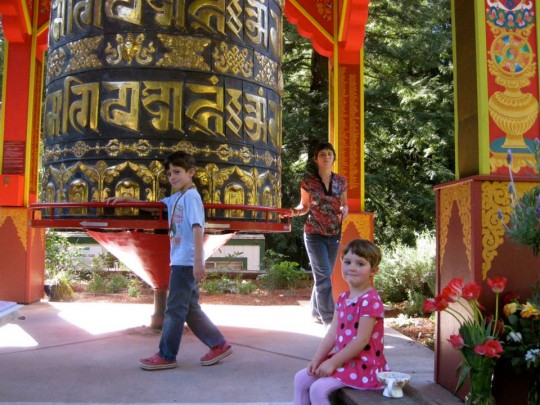
The Waite family during their 3:30 pm spin, April 2014. Photo via Facebook, Land of Medicine Buddha.
On April 6, students of Land of Medicine Buddha in Soquel, California launched a 24-hour “Wheelathon” fundraiser for the construction of a four-story replica of the Mahabodhi Stupa on their property. The original Mahabodhi Stupa in Bodhgaya, India, marks to the site where Buddha achieved enlightenment.
At least 25 people, including nuns and monks, took shifts spinning Land of Medicine Buddha’s large prayer wheel with the goal of raising US$1,000 an hour. Community members were invited to help spin the wheel as well as recite prayers and mantras. The Great Prayer Wheel contains over 170 billion mantras and millions of Buddhist texts printed on microfilm. Students prepared a promotional video to encourage community members to participate:
Over 193 sponsors offered or pledged more than US$35,000 by the end of the event, a huge step forward for the estimated US$815,000 project. Lama Zopa Rinpoche has already personally pledged US$50,000 in support of the immense undertaking.
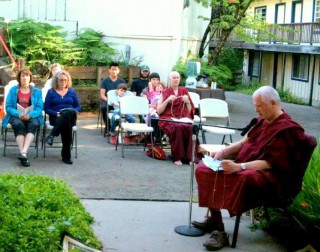
Ven. Steve Carlier leading “Prayer to the Six Syllable Great Compassionate One,” April 2014. Photo via Facebook, Land of Medicine Buddha.
The Mahabodhi Stupa at Land of Medicine Buddha will not only help to preserve pan-Buddhist culture and serve as an educational site, but will also be designed to honor people such as His Holiness the Dalai Lama, Mother Theresa, Martin Luther King, Jr., Thich Nhat Hanh and others who have tirelessly promoted world peace.
The ground blessing ceremony for the new stupa with Geshe Ngawang Dakpa, resident geshe of Tse Chen Ling in San Francisco, and a group of Gyuto monks is scheduled for April 25.
Visit Land of Medicine Buddha online to learn more about the planned Mahabodhi Stupa and its current campaign.
Mandala brings you news of Lama Zopa Rinpoche and of activities, teachings and events from over 160 FPMT centers, projects and services around the globe. If you like what you read on Mandala, consider becoming a Friend of FPMT, which supports our work.
- Tagged: holy objects, land of medicine buddha, mandala, prayer wheels
- 0
18
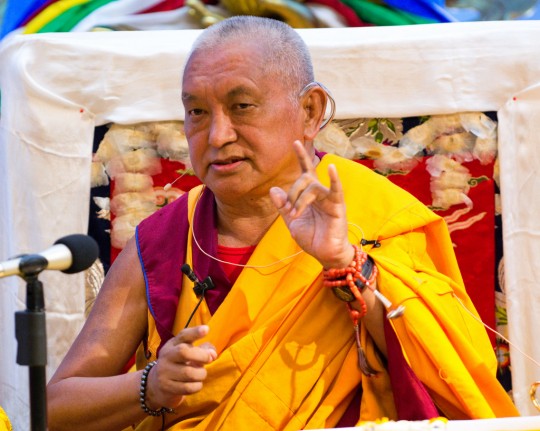
Lama Zopa Rinpoche at Maitripa College, Oregon, US, June 2012. Photo by Marc Sakamoto.
On Saturday, April 19 at 7 p.m. PDT, Lama Zopa Rinpoche will offer a Vajrasattva initiation at Maitripa College in Portland, Oregon, United States. Then on Monday, April 21 at 7 p.m., Rinpoche will offer the oral transmission of the preliminary practice of Dorje Khadro. All public portions of the Vajrasattva initiation and oral transmission will be webcast live courtesy of Maitripa College.
Lama Zopa Rinpoche arrived in the United States in early April, staying at Buddha Amitabha Pure Land in rural northcentral Washington State before coming south to Portland for the teachings at Maitripa.
In early May, Rinpoche will be teaching at the Light of the Path Retreat in North Carolina, US. The teachings during the retreat will be streamed live as well as made available after the event on demand.
More information, photos, schedule and updates about FPMT spiritual director Lama Zopa Rinpoche can be found on Rinpoche’s homepage. If you’d like to receive news of Lama Zopa Rinpoche via email, sign up to Lama Zopa Rinpoche News.
- Tagged: lama zopa rinpoche, maitripa college, mandala, video
- 0
16
In 1975, FPMT founder Lama Yeshe explained why “meditation is simple” to a group of students in Bloomington, Indiana, United states. Mandala shared some of that teaching in the September-November 2002 issue:
Meditation is very simple. When hearing about meditation for the first time, you might think, “That must be very special; meditation couldn’t be for me but only for special people.” This just creates a gap between you and meditation.
Actually, watching television, which we all do, is a bit like meditating. When you watch television, you watch what’s happening on the screen; when you meditate, you watch what’s happening on the inner screen of your mind – where you can see all your good qualities, but all your inner garbage as well. That’s why meditation is simple.
The difference, however, is that through meditation you learn about the nature of your mind rather than the sense world of desire and attachment. Why is this important? We think that worldly things are very useful, but the enjoyment they bring is minimal and transient. Meditation, on the other hand, has so much more to offer – joy, understanding, higher communication and control. Control here does not mean that you are controlled by somebody else but rather by your own understanding knowledge-wisdom, which is a totally peaceful and joyful experience. Thus, meditation is very useful.
From Mandala September-November 2002
15
The Twins: Faith and Doubt
Stephen Batchelor shares his views in the September-November 2002 issue with Mandala editor Nancy Patton on agnosticism, and whether one can have both faith and doubt about the Buddhist path:
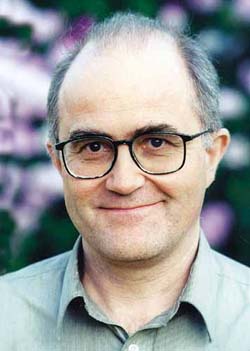
NP: I’ve heard you describe your agnostic views as deep agnosticism. How does that differ from the accepted view of agnosticism (which, interestingly, you say, is a term coined by Thomas Huxley, in the late 1880s, so he could have a label like his fellow philosophers who were Christians, Rationalists and the like.)
SB: Deep agnosticism, for me, brings together the idea of agnosticism as found in Western secular culture, and a kind of not-knowing that is cultivated in the practice of certain kinds of Buddhist meditation. In the practice of Zen, for example, you ask yourself a question: “What is this?” You ask this not as an intellectual enquiry, but rather as a way of opening up the primary question that your life poses to you. In other words, “Who am I?” Ultimately, this is the heart of all Buddhist practice – to find out what is the nature of the self, of reality, of consciousness, or however we would frame that.
But, of course, every time you ask a question, you are implicitly saying that you do not know something. That kind of not-knowing is an a-gnosis taken down to a deeper pitch. The not-knowing of agnosticism, as it is often understood today, is a lack of interest in knowing, or having opinions about, certain questions like, “What happens after death? Where did the universe come from? Is there a God?” An agnostic is someone who says, “I just don’t know.”
I am interested in taking that “don’t know” into a deep existential enquiry which seems to be very close to what you find in China with the idea of wu-hsin, which means “no mind.” It also has parallels with the whole nature of enquiry into emptiness. In the teachings of Lama Tsongkhapa, for example, you apply what’s called dondam choje kyi rigpa, which means an analysis into the ultimate nature of things. And that too is a form of intense meditative enquiry, which seeks to critique the false sense of ego that we all suffer from and, in exploding that illusion, opens up the world as radically contingent and changing. That enquiry is likewise starting from a place where you are saying, “I don’t know the nature of reality.”
From Mandala September-November 2002
9
Jampa Jaffe, FPMT registered teacher, answers in the April-June 2014 issue of Mandala the question: why does Buddhism place so much emphasis on the mind?
In emphasizing the mind, Buddhism is stressing that when we look to a person, a thing or a situation for the solutions to our fundamental problems, we’re projecting outside what can only be found within.
In our everyday living, we too often behave like the person who has lost his keys along a dark street and yet searches for them beneath a streetlight on the corner, thinking it much easier to see them there. However, the reality is that no matter how long and hard he searches, he will never find what he’s looking for, because he’s looking in the wrong place.
There’s a simple story based on a verse from Shantideva’s A Guide to the Bodhisattva’s Way of Life that illustrates Buddhism’s emphasis on the mind. There was a king in ancient times who took great pleasure in strolling about the countryside of his kingdom. One day, while out walking, he stepped on a thorn, injuring his foot. Returning to his palace in great pain, the king called together his ministers. “Look,” he exclaimed, “Look at my foot! This cannot be allowed to happen again! You must find a way whereby I can walk freely about my kingdom without the danger of hurting myself!” …
From Mandala April-June 2014
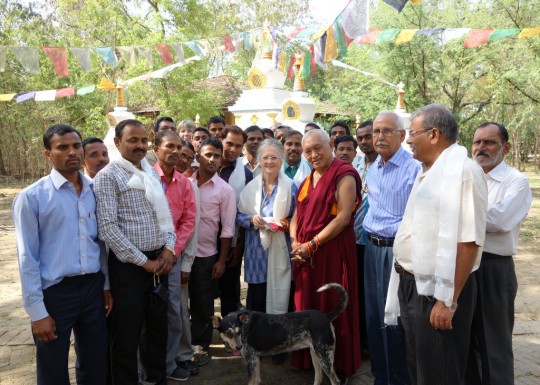
Lama Zopa Rinpoche with Adriana Ferranti and the staff of MAITRI Charitable Trust, Bodhgaya, India, March 2014. Photo by Ven. Roger Kunsang.
Lama Zopa Rinpoche visited MAITRI Charitable Trust, an FPMT project in Bodhgaya, India that offers a wide array of health and education programs to the very poor in the area as well as care to animals.
Children from the villages surrounding Bodhgaya lined up to greet Rinpoche upon his arrival. The children attend schools overseen by MAITRI. Rinpoche came to give a talk and advice to the children.
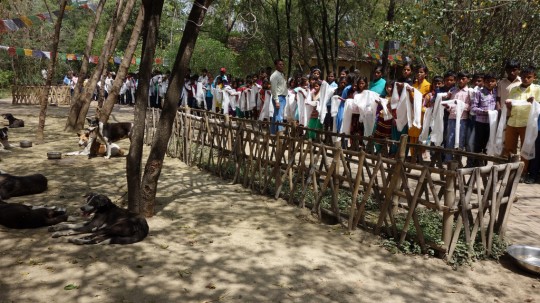
Children greeting Lama Zopa Rinpoche at MAITRI, Bodhgaya, India, March 2014. Photo by Ven. Roger Kunsang.
During his visit, Rinpoche also thanked Adriana Ferranti, who founded and directs MAITRI, and the project’s skilled staff who do all the incredible good work helping poor, uneducated mothers and children, those with leprosy and tuberculosis, and animals as well as doing HIV/AIDS awareness campaigns and providing humanitarian aid to those most in need.
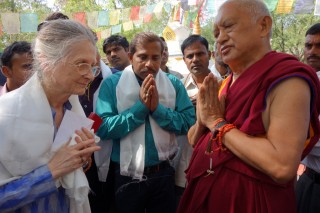
Rinpoche thanking Adriana and MAITRI staff, Bodhgaya, India, March 2014. Photo by Ven. Roger Kunsang.
MAITRI began its work in 1989 helping people with leprosy and working towards its eradication. Since then, the project has expanded greatly to meet the needs of the people in the Bodhgaya-area in Bihar, one of the poorest, most depressed and most populated states in India.
At present, MAITRI has 105 stray dogs they care for, most arriving with severe injuries and sickness. The staff does their best to provide them with the medical attention they need. Usually they are able to roam the entire property of MAITRI, but on the day of Rinpoche’s visit, with so many visitors, including so many children, they were tied up.
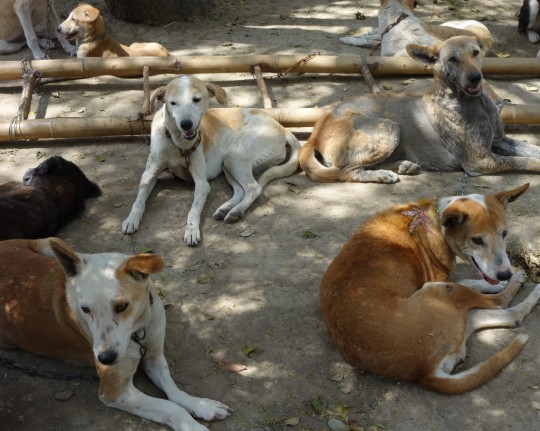
Dogs at MAITRI, Bodhgaya, India, March 2014. Photo by Ven. Roger Kunsang.
The project also cares for rescued goats. In addition, MAITRI has a veterinarian clinic to which local people can bring their animals.

Goats at MAITRI, Bodhgaya, India, March 2014. Photo by Ven. Roger Kunsang.
More information, photos and updates about FPMT spiritual director Lama Zopa Rinpoche can be found on Rinpoche’s homepage. If you’d like to receive news of Lama Zopa Rinpoche via email, sign up to Lama Zopa Rinpoche News.
You can learn more about MAITRI Charitable Trust online and read Mandala’s coverage of the project’s work.
5
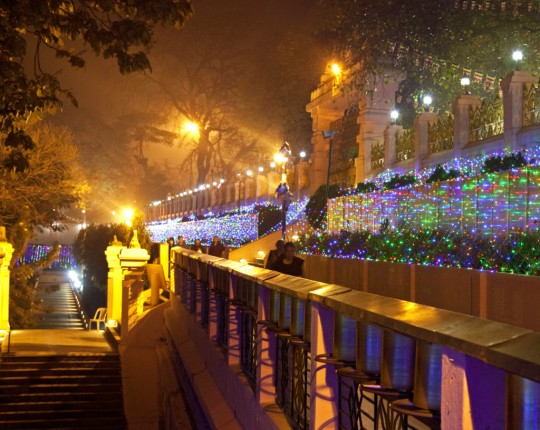
Lama Zopa Rinpoche doing korwa at the Mahabodhi Temple, Bodhgaya, India, March 2014. Photo by Andy Melnic.
“… On the basis of [reflecting on the lam-rim], we should generate the good heart, bodhichitta, the thought of benefiting others. This is our best refuge, especially for those of us whose lives are very busy, who don’t have much time for sitting or other traditional forms of practice. On the basis of reflecting on impermanence and death, we should make the good heart the main object of refuge in our lives. This allows all our actions to become Dharma, the cause of enlightenment and the cause of happiness for all sentient beings. Therefore, we should lead our lives with this attitude, the thought of benefiting all sentient beings.
“If you recite a Vajrasattva mantra once with bodhichitta you get the same benefit as you do from reciting 100,000 without it. If you make one light offering with bodhichitta, you get the same amount of merit as you do from making 100,000 light offerings without it. If you make charity of one dollar to a sentient being – a beggar or a homeless person – with bodhichitta, you get the same amount of merit as you do from making charity of $100,000 without it.
“It is said in the scriptures that if the sentient beings of three galaxies – the Tibetan term is tong-sum, but I’m not exactly sure how best to translate it, you should check for yourselves – all build stupas of the seven precious substances, such as gold, diamonds and so forth, and fill the whole world with these stupas, the merit of that is far less than that created by just one person offering a tiny flower to the Buddha with bodhichitta motivation. The person making this small offering with bodhichitta motivation creates far more merit than three galaxies of sentient beings covering the world with stupas made of the seven precious substances without it.
“Try to imagine this. If you build just one stupa you create unbelievable merit. It directs your life to enlightenment and is an amazing purification. So here we have three galaxies’ worth of sentient beings, each one building a stupa of the seven precious substances – not with bricks and mortar but with precious jewels – and covering the world with these. Nevertheless, the merit of one person offering a tiny flower to the Buddha with bodhichitta motivation creates far more merit than that.
“Thinking about this should inspire you to make bodhichitta your heart practice. It transforms your life like iron into gold or kaka into diamonds. Bodhichitta motivation gives your life its greatest possible meaning and makes every single action of your daily life as beneficial as it can possibly be. You should remember bodhichitta from morning to night, twenty-four hours a day. Hold it as your most precious possession, as your wish-fulfilling jewel. You should cherish your bodhichitta motivation above all else; remember it constantly and practice it at every moment. …”
– Lama Zopa Rinpoche, from The Joy of Compassion, “Chapter One: Living with Compassion,” published by the Lama Yeshe Wisdom Archive
Learn more about FPMT spiritual director Lama Zopa Rinpoche and his beneficial activities by visiting Rinpoche’s homepage, where you will find links to Rinpoche’s schedule, new advice, recent video, photos and more.
- Tagged: bodhichitta, lama zopa rinpoche, mandala
- 0
On a smaller scale than the Maitreya Projects and the Great Stupa of Universal Compassion, dozens of FPMT centers, projects and services have built or are in the process of creating their own stupas, often representing a true community effort. Each one of these stupas brings FPMT closer to realizing Lama Zopa Rinpoche’s wish to build 100,000 stupas around the world. (To learn more, visit the FPMT Stupa Fund page.)
Pamtingpa Center, a small center located in Tonasket, Washington, US, shared with Mandala their story of building a stupa, demonstrating that even when resources seem limited, it is possible to do it. You can read their story online.
Here are photos of their progress over the last year …
From Mandala April-June 2014
Mandala brings you news of Lama Zopa Rinpoche and of activities, teachings and events from over 160 FPMT centers, projects and services around the globe. If you like what you read on Mandala, consider becoming a Friend of FPMT, which supports our work.
2
Living the Gift

“Burning Man: Spread the LOVE” by Sarah Bartell (Flickr: Little Lioness), August 2011. Creative Commons Attribution.
Buddhist in the Trenches columnist Sarah Shifferd talks about how the gift economy and generosity intersect in the April-June 2014 issue of Mandala:
I’ve never believed in money. Even though my parents explained the basics of modern economics to me over and over while I was growing up, I wasn’t convinced. Don’t get me wrong. I understood that the vast majority of people believed the economy followed certain rules; I understood our society ran on this obviously artificial system. However, that understanding didn’t make me believe. I told my parents, “Money isn’t real.”
But I lived in a society where most people believed money was real, so sometime in my early twenties, I tucked my discomfort away in a corner of my mind. It surfaced only occasionally: when as a musician, I (politely) refused money for solo concerts or simply left the building before anyone could find me to pay me. I gave cello lessons at a reduced cost that occasionally became zero. The best payment was helping someone discover and learn. Money was entirely irrelevant. …
Read Sarah’s complete piece as part of Mandala’s online edition for this issue.
Mandala brings you news of Lama Zopa Rinpoche and of activities, teachings and events from over 160 FPMT centers, projects and services around the globe. If you like what you read on Mandala, consider becoming a Friend of FPMT, which supports our work.
2
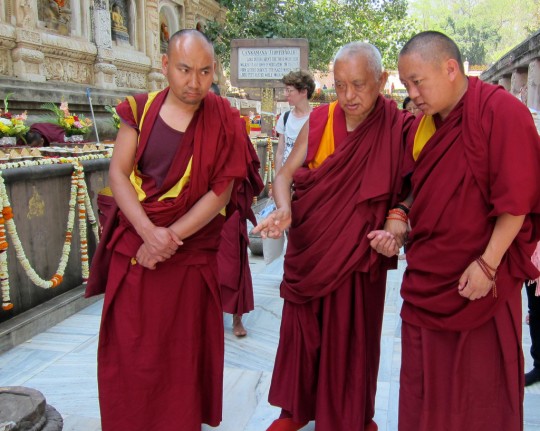
Lama Zopa Rinpoche circumambulating the Mahabodhi Stupa, Bodhgaya, India, March 2014. Photo by Ven. Sarah Thresher.
By Ven. Sarah Thresher
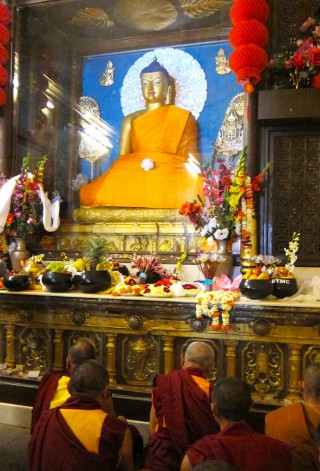
Lama Zopa Rinpoch making extensive prayers and dedications, Mahabodhi Stupa, Bodhgaya, India, March 2014. Photo by Ven. Sarah Thresher.
While Lama Zopa Rinpoche has been staying at Root Institute in Bodhgaya, India, he has been engaged in many practices during Losar and the two weeks that follow. Ven. Sarah Thresher has been participating in these virtuous activities and shared this report.
Rinpoche has gone nearly every day of the 15 miracle days to the stupa to do korwa [circumambulation], bless the light offerings and give the transmission of the Sutra of Golden Light.
On the Tibetan 15th, Chotrul Duchen, Rinpoche went to the stupa in the late morning after giving the Eight Mahayana Precepts at Root Institute. He did some circumambulation while reciting Lama Tsongkhapa’s Lekshay Nyingpo and then offered robes and bowls full of fruit and other offerings to the Buddha statue in the main shrine with extensive prayers and dedications for all the students and benefactors in the organization, for world peace, for all the centers and projects and for all sentient beings.
It’s very important to Rinpoche not to waste a moment of opportunity to purify and accumulate merit with this precious human life and to always motivate with bodhichitta and dedicate in the most extensive way for all sentient beings while remembering emptiness.
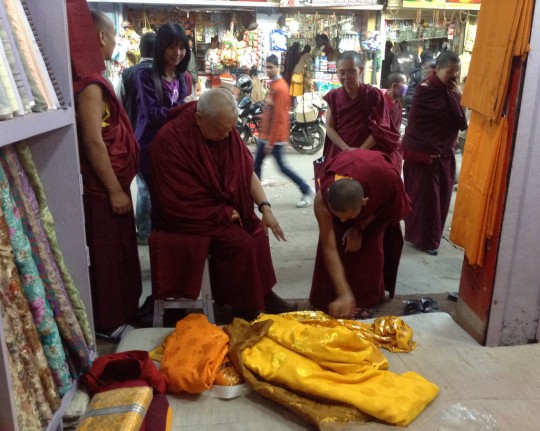
Lama Zopa Rinpoche in the market choosing the exact material to be offered to the Buddha statue inside the Mahabodhi Stupa, Bodhgaya, India, February 2014. Photo by Ven. Sarah Thresher.
Read more from Ven. Sarah Thresher on Rinpoche’s activities during Monlam.
Every month the Lama Zopa Rinpoche Bodhichitta Fund sponsors the offering of robes to the Buddha inside the Mahabodhi Stupa. Visit the fund’s website to learn more.
Learn more about Lama Zopa Rinpoche, spiritual director of the Foundation for the Preservation of Mahayana Tradition (FPMT), and Rinpoche’s vision for a better world. Sign up to receive news and updates.
- Tagged: bodhgaya, lama zopa rinpoche, mahabodhi stupa, mandala
- 0
- Home
- News/Media
- Study & Practice
- About FPMT Education Services
- Latest News
- Programs
- New to Buddhism?
- Buddhist Mind Science: Activating Your Potential
- Heart Advice for Death and Dying
- Discovering Buddhism
- Living in the Path
- Exploring Buddhism
- FPMT Basic Program
- FPMT Masters Program
- FPMT In-Depth Meditation Training
- Maitripa College
- Lotsawa Rinchen Zangpo Translator Program
- Universal Education for Compassion & Wisdom
- Online Learning Center
- Prayers & Practice Materials
- Overview of Prayers & Practices
- Full Catalogue of Prayers & Practice Materials
- Explore Popular Topics
- Benefiting Animals
- Chenrezig Resources
- Death & Dying Resources
- Lama Chopa (Guru Puja)
- Lama Zopa Rinpoche: Compendium of Precious Instructions
- Lama Zopa Rinpoche: Life Practice Advice
- Lama Zopa Rinpoche Practice Series
- Lamrim Resources
- Mantras
- Prayer Book Updates
- Purification Practices
- Sutras
- Thought Transformation (Lojong)
- Audio Materials
- Dharma Dates – Tibetan Calendar
- Translation Services
- Publishing Services
- Teachings and Advice
- Find Teachings and Advice
- Lama Zopa Rinpoche Advice Page
- Lama Zopa Rinpoche: Compendium of Precious Instructions
- Lama Zopa Rinpoche Video Teachings
- ༧སྐྱབས་རྗེ་བཟོད་པ་རིན་པོ་ཆེ་མཆོག་ནས་སྩལ་བའི་བཀའ་སློབ་བརྙན་འཕྲིན།
- Podcasts
- Lama Yeshe Wisdom Archive
- Buddhism FAQ
- Dharma for Young People
- Resources on Holy Objects
- Ways to Offer Support
- Centers
- Affiliates Area
- Teachers
- Projects
- Charitable Projects
- Make a Donation
- Applying for Grants
- News about Projects
- Other Projects within FPMT
- Support International Office
- Projects Photo Galleries
- Give Where Most Needed
- FPMT
- Shop
Subscribe to FPMT News
Translate*
*powered by Google TranslateTranslation of pages on fpmt.org is performed by Google Translate, a third party service which FPMT has no control over. The service provides automated computer translations that are only an approximation of the websites' original content. The translations should not be considered exact and only used as a rough guide.We hear religious people talk a lot about morality. What is morality? Morality is the wisdom that understands the nature of the mind. The mind that understands its own nature automatically becomes moral, or positive; and the actions motivated by such a mind also become positive. That’s what we call morality. The basic nature of the narrow mind is ignorance; therefore the narrow mind is negative.







